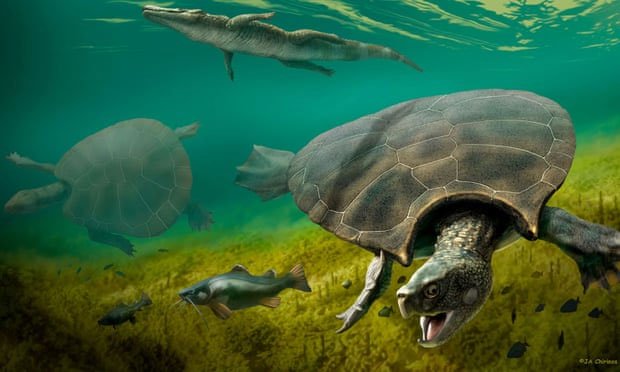Fossils of giant tortoise-eating snakes found in South America
Stupendemys geographicus, the tortoise with strong horns, lived 13 to 7 million years ago during the same period as the giant crocodile.
Scientists have unearthed the fossil of one of the largest turtles ever to be the size of a car, living near the lakes and rivers of what is today the northern part of South America from about 13. to 7 million years ago.

Figure simulating turtle Stupendemys geographicus.(Image: JA Chirinos / Reuters)
Fossils of Stupendemys geographicus have been found in the Tatacoa Desert in Colombia and the Urumaco region in Venezuela for the first time providing comprehensive insights into the species up to 4 meters long and weighing up to 1.25 tons.
Males have a pair of horns that protrude on both sides of the shell near the neck. Deep fossils indicate that these horns may have been the tortoise's weapons for fighting other males when fighting for mates or territories. Children without horns.
According to paleontologist Edwin Cadena of the University of del Rosario in Bogotá, who led the study, published in the journal Science Advances, the competition still occurs in some species of living turtles, especially between the male turtles.
Stupendemys is the second largest known turtle , after the Archelon sea turtle, about 4.6 meters long, lived about 70 million years ago at the end of the dinosaur period.
The first Stupendemys fossil was found in the 1970s but there are still many mysteries about this animal. The new fossil includes the largest known turtle shell, 2.86 m, larger than the Archelon shell; and lower jaw, showing clues to the species diet.
'Stupendemys geographicus is very big and heavy. The largest individuals of this species are the size and length of a sedan if they include the head, neck, shell and limbs, ' says Mitch Cadena.

Biologist researcher Rodolfo Sanchez is located next to a giant tortoise Stupendemys geographicus, from Urumaco, Venezuela.(Photo: PA).

The giant tortoise is 8 feet long.

The giant shell is used in the battle of the tortoise Stypendemys geographicus.
'Its diet is varied, including small animals such as fish, snakes, molluscs and plants, especially fruits and nuts. A summary of all the anatomical characteristics of this species shows that it mainly lives on the bottom of large freshwater areas, ' Mitch Cadena adds.
Stupendemys, which means 'magical turtles' , lived in the giant swampy area that stretches across what is now Colombia, Venezuela, Brazil and Peru before the Amazon and Orinoco rivers were formed.
Its huge size can be very important against formidable predators. It lived with giant crocodiles including Purimanaurus species about 11m long and Gryposeuchus 10m long trunk. One of the fossils of Stupendemys was found along with the 5cm alligator tooth attached to it.
- Thrilling story of giant turtles attacking buffalo in the middle of the Red River
- The unknown story about the giant tortoise, weighing nearly 1 ton
- Giant turtles reappear after 150 years of extinction
- Detection of giant bear fossils
- Huge giant turtle by car
- Found descendants of the extinct 'lonely George' turtle
- Strange little known about snakes
- Discovered large bats from fossils 19 million years
- Discover the oldest predatory fossil species in South America
- Poisonous snakes almost extinct re-export makes experts happy to cry
- Giant water bugs catch snakes eating meat
- Detecting fossils of the snakehead dragon
- Giant snakes quietly 'invaded' America
- Tomorrow tortoise is not to do something like you think
- Giant pythons of South America can swallow crocodiles
 Discovered an ancient centipede fossil 99 million years old
Discovered an ancient centipede fossil 99 million years old Discovered bat-like dinosaurs in China
Discovered bat-like dinosaurs in China Discovered a 200-year-old bronze cannon of the coast
Discovered a 200-year-old bronze cannon of the coast Discover 305 million-year-old spider fossils
Discover 305 million-year-old spider fossils